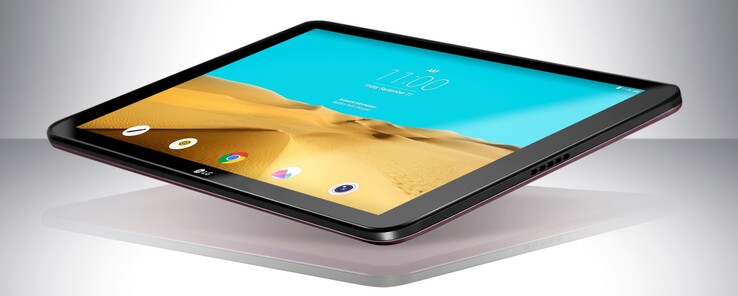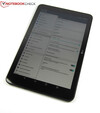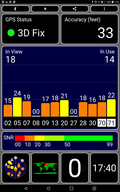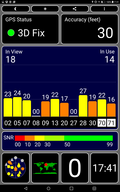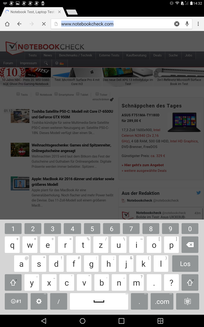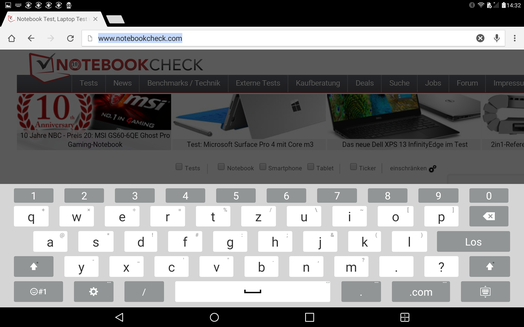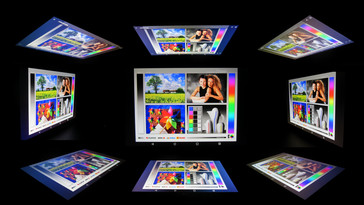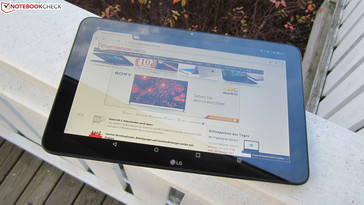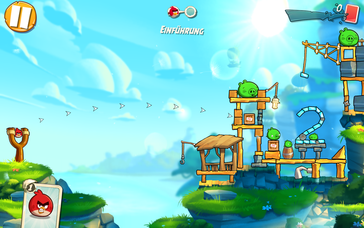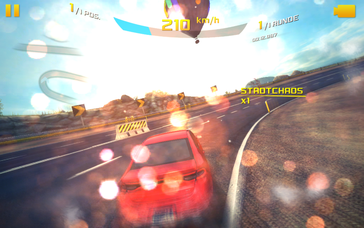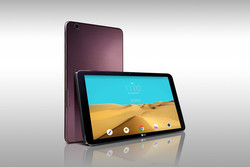LG G Pad II 10.1 Tablet Review
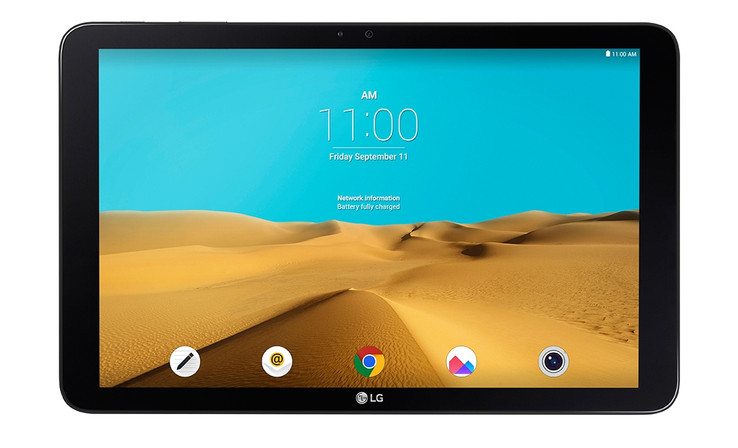
For the original German review, see here.
Take a 10.1-inch IPS screen with a resolution of 1920x1200 pixels and the Qualcomm Snapdragon 800 MSM8974 quad-core processor and blend with 2 GB of RAM and 16 GB of eMMC storage, and LG's G Pad II 10.1 tablet is ready to use. LG definitely does not have much say in the race for the Tablet of the Year with this solid yet somewhat stale hardware base. However, that was not the manufacturer's intention. It rather categorizes the plain G Pad II 10.1 as a multimedia all-rounder that looks equally good in entertainment, performance and productivity. The quad-core SoC clocked at 2.26 GHz is easily enough for that.
LG has equipped its tablet with Android 5.1.1 and a range of practical features. Among them, a "Reader Mode" that reduces the blue light emissions to spare the user's eyes when reading e-books or browsing on the Internet. As in LG's G3 and G4 smartphones, two apps can be displayed on the screen at the same time in "Dual-Window Mode". Although that is currently possible with only 13 apps, among them Google Chrome, Google Docs, Gmail and YouTube, it provides a better overview and will please multitasking fans. Productivity users will use the pre-loaded Microsoft Office suite or the Quick-Memo feature to write a quick note on the screen. The G Pad II 10.1 is powered by a 7400 mAh battery, which, according to the manufacturer should deliver enough energy for a whole workday.
LG demands approximately 450 Euros (~$491) for the G Pad II. The buyer also gets an LTE radio module, a 5 megapixel primary camera as well as Full HD screen, quad-core SoC and 16 GB of storage. We use the similarly equipped Acer Iconia Tab 10 A3-A30, Lenovo TAB 2 A10-70, Samsung Galaxy Tab S2 9.7 LTE and Sony Xperia Z4 tablets for comparisons with the G Pad II 10.1.
Case
LG's 10.1-inch tablet is encased in a robust plastic casing with a stylish black and metallic looks. However, as with the glossy display surface, the back cover attracts fingerprints quickly. They disappear just as fast after a quick wipe with a microfiber cloth.
Although there are no metal parts on the outside, and the G Pad II 10.1 is very slim with a height of 7.8 millimeters (~0.31 in), exceptionally solid and pressure resistant. Its light weight of just less than 490 grams (~1.1 lb) makes it pleasant to hold when, for example, reading texts. However, considering the tablet's dimensions of 25.4 x 16.1 centimeters (~10 x 6.3 in), both hands will be needed for smooth and proper handling. The battery cannot be accessed. It is fixed inside the casing and the back cover cannot be removed.
Connectivity
The few interfaces fit the unobtrusiveness of the G Pad II 10.1. Besides the compulsory power button and volume rocker on the tablet's upper edge, and a headset jack on the left, only two other ports are found on the casing: one slot for a micro-SD and another for a micro-SIM card. Both are behind removable flaps that are also on the tablet's upper edge. According to the specifications, the G Pad II 10.1's 16 GB internal storage can be expanded with a micro-SD card with a capacity of up to 2 TB. This sounds good, but is still far from reality. Apart from very few exceptions like SanDisk's Ultra microSDXC 200 GB, no micro- SDXC cards currently goes beyond 128 GB. Compatible apps can easily be moved to the memory card after installation.
Software
A relatively new version of Google's Android 5.1.1 Lollipop operating system runs on LG's G Pad II 10.1. Numerous apps are also pre-loaded, starting with Microsoft's Office suite and Google's apps. LG has also installed several proprietary apps, such as the "Dual-Window" multitasking app. It divides the screen into two equal parts in both portrait and landscape mode where an app can be opened. That makes it possible, for example, to chat and watch a video on each half of the screen at the same time. Calls and notifications from social networks received on a mobile phone can be forwarded to the tablet and answered via the "QPair" app. The "QuickMemo" app allows jotting down and sharing notes – these can be entered by simply drawing on the tablet with a finger. The "QuickRemote" app is a nice bonus. The combination of "QuickRemote" and the integrated infrared sensor allows the tablet to act as a remote control for compatible appliances, such as TVs or Blu-ray players.
The extensive software bundle reduces the available storage capacity significantly. Only about 9.3 GB of the initial 16 GB are left in a new or factory reset state.
Communication & GPS
LG's G Pad II 10.1 is state-of-the-art in terms of communication. In addition to GSM quad-band and UMTS dual band (900 and 2100 MHz), the tablet also supports high-speed LTE Cat. 4 and achieves download rates of up to 150 MBit/s, provided the user has the matching mobile plan. The tablet is also fast in local networks with Wi-Fi 802.11 a/b/g/n/ac, and can transmit in both the 2.4 and 5 GHz frequencies. The reception signal during the tests was always good. LG's tablet also supports Bluetooth 4.1, but not NFC. The integrated GPS module located us quickly and reliably with a deviation of only a few meters in the test.
Cameras & Multimedia
While the 2 megapixel webcam in LG's G Pad II 10.1 has a resolution of 1920x1080 pixels, the 5 megapixel primary camera with auto focus takes photos with up to 2560x1920 pixels and allows recording Full HD videos at 30 frames per second. Although these are decent key features, the cameras' photo quality are mostly average. No one expects photographic masterpieces from webcams in mobile devices, but the primary camera should take good pictures. Unfortunately, LG's G Pad II 10.1 cannot do that. Compared with the photos taken with the Sony Alpha 57 reference camera and the superb cameras in Apple's iPad Air 2 and Sony's Xperia Z2, the photos from LG's tablet look low-contrast to pale, display far too much noise, and details sometimes disappear in a haze of pixels. However, the camera is just sufficient for casual photographers.
Accessories & Warranty
LG ships the G Pad II 10.1 with a modular power supply, USB cable and a quick start guide. The manufacturer does not offer optional accessories on its website. A 24-month warranty is included on the tablet; wear parts like the battery and cable are covered for only 6 months.
Input Devices & Handling
The capacitive, 10-point multi-touch screen in LG's G Pad II 10.1 responds accurately to inputs in every corner, and quickly rotates horizontally and vertically depending on how it is held. The glossy display surface presents the fingers with agreeably low resistance. The Android navigation icons and the "Dual-Window" icons for displaying two apps simultaneously are always available on the screen, and are faded out automatically when not in use.
Regardless of how the tablet is held, the virtual keyboard takes approximately one third of the screen's surface, leaving enough room to see contents. The good layout and pleasantly sized keys allow fast typing. The permanently visible number row above the keyboard makes switching unnecessary.
The physical power button and volume rocker have a short drop, but respond quickly and convince with their accurate pressure point.
Display
LG's G Pad II 10.1 reproduces the WUXGA resolution of 1920x1200 pixels on its IPS screen, which results in razor-sharp images. With an average of 367 cd/m², LG's tablet accomplishes high brightness and scores with a fairly homogeneous illumination of the display's surface. The user can enable the ambient light sensor that automatically adapts the brightness to the actual light conditions. The black level of 0.53 cd/m² and contrast ratio of 670:1 are not top rates in terms of measurements, but subjectively, the reproduction is almost beyond reproach. All contents are displayed with bright colors. The screen's reflective surface naturally lets the colors look slightly more brilliant than they actually are. The black reproduction, however, could have been slightly deeper. The G Pad II 10.1 does not manage more than a very dark gray.
| |||||||||||||||||||||||||
Brightness Distribution: 89 %
Center on Battery: 355 cd/m²
Contrast: 670:1 (Black: 0.53 cd/m²)
ΔE ColorChecker Calman: 3.2 | ∀{0.5-29.43 Ø4.78}
ΔE Greyscale Calman: 4.36 | ∀{0.09-98 Ø5}
Gamma: 2.2
CCT: 7240 K
| LG G Pad II 10.1 Adreno 330, 800 MSM8974, 16 GB eMMC Flash | Acer Iconia Tab 10 A3-A30 HD Graphics (Bay Trail), Z3735F, 32 GB eMMC Flash | Lenovo TAB2 A10-70 Mali-T760 MP2, MT8165, 16 GB eMMC Flash | Samsung Galaxy Tab S2 9.7 LTE Mali-T760 MP6, Exynos 5433, 32 GB eMMC Flash | Sony Xperia Z4 Tablet Adreno 430, 810 MSM8994, 32 GB eMMC Flash | |
|---|---|---|---|---|---|
| Screen | -18% | 28% | 21% | -29% | |
| Brightness middle (cd/m²) | 355 | 343 -3% | 352.9 -1% | 358 1% | 471 33% |
| Brightness (cd/m²) | 367 | 328 -11% | 335 -9% | 357 -3% | 457 25% |
| Brightness Distribution (%) | 89 | 88 -1% | 88 -1% | 86 -3% | 92 3% |
| Black Level * (cd/m²) | 0.53 | 0.38 28% | 0.191 64% | 0.46 13% | |
| Contrast (:1) | 670 | 903 35% | 1848 176% | 1024 53% | |
| Colorchecker dE 2000 * | 3.2 | 6.86 -114% | 4.31 -35% | 1.78 44% | 8.69 -172% |
| Greyscale dE 2000 * | 4.36 | 6.95 -59% | 4.36 -0% | 1.38 68% | 11.24 -158% |
| Gamma | 2.2 100% | 2.32 95% | 2.33 94% | 2.24 98% | 2.17 101% |
| CCT | 7240 90% | 7249 90% | 7045 92% | 6366 102% | 9508 68% |
| Color Space (Percent of sRGB) (%) | 99 |
* ... smaller is better
Some weaknesses in reproduction are seen when examining LG's tablet with the X-Rite i1Pro 2 colorimeter and CalMAN software. The color temperature of 7240K is above the ideal rate of 6500K. This leads to somewhat too high blue parts in contrast to red parts that are too low (DeltaE of 3.20). The grayscale reproduction is not quite ideal, either (DeltaE of 4.36). However, these points will hardly be noticed during use, if at all.
As typical for an IPS screen, the viewing angle stability of the G Pad II 10.1 is very good. Although the image brightens up slightly in extreme side views, the content is still impeccably legible. However, this does not necessarily apply to outdoor use due to the highly glossy screen. Despite the good brightness, it will soon become strenuous for the eyes to recognize something on the tablet on bright days or in sunlight. LG's tablet can be best used in a shaded place or indoors.
Performance
LG's G Pad II 10.1 is based on a high-performance foundation with the Qualcomm Snapdragon 800 MSM8974 quad-core processor that according to the specification sheet clocks at up to 2.26 GHz. Compared with other current tablets, it is seen that the SoC installed in mobile devices for the first time in 2013 can keep up well, but is now slightly outperformed. The overall performance of LG's tablet is roughly on par with Acer's Iconia Tab 10 A3-A30 that is powered by an Intel Atom Z3735F. Samsung's Galaxy Tab S2 9.7 LTE and Sony's Xperia Z4 are even slightly faster, but do not achieve a very big lead.
| Geekbench 3 | |
| 32 Bit Single-Core Score (sort by value) | |
| LG G Pad II 10.1 | |
| Acer Iconia Tab 10 A3-A30 | |
| Lenovo TAB2 A10-70 | |
| Sony Xperia Z4 Tablet | |
| 32 Bit Multi-Core Score (sort by value) | |
| LG G Pad II 10.1 | |
| Acer Iconia Tab 10 A3-A30 | |
| Lenovo TAB2 A10-70 | |
| Sony Xperia Z4 Tablet | |
| Linpack Android / IOS | |
| Single Thread (sort by value) | |
| Acer Iconia Tab 10 A3-A30 | |
| Samsung Galaxy Tab S2 9.7 LTE | |
| Sony Xperia Z4 Tablet | |
| Multi Thread (sort by value) | |
| Acer Iconia Tab 10 A3-A30 | |
| Samsung Galaxy Tab S2 9.7 LTE | |
| BaseMark OS II - Overall (sort by value) | |
| LG G Pad II 10.1 | |
| Acer Iconia Tab 10 A3-A30 | |
| Lenovo TAB2 A10-70 | |
| Samsung Galaxy Tab S2 9.7 LTE | |
| Sony Xperia Z4 Tablet | |
| AnTuTu v5 - Total Score (sort by value) | |
| LG G Pad II 10.1 | |
| Acer Iconia Tab 10 A3-A30 | |
| Lenovo TAB2 A10-70 | |
| Samsung Galaxy Tab S2 9.7 LTE | |
| Sony Xperia Z4 Tablet | |
| PCMark for Android - Work performance score (sort by value) | |
| LG G Pad II 10.1 | |
| Acer Iconia Tab 10 A3-A30 | |
| Lenovo TAB2 A10-70 | |
| Samsung Galaxy Tab S2 9.7 LTE | |
| Sony Xperia Z4 Tablet | |
| GFXBench (DX / GLBenchmark) 2.7 | |
| T-Rex Onscreen (sort by value) | |
| LG G Pad II 10.1 | |
| Acer Iconia Tab 10 A3-A30 | |
| Samsung Galaxy Tab S2 9.7 LTE | |
| Sony Xperia Z4 Tablet | |
| 1920x1080 T-Rex Offscreen (sort by value) | |
| LG G Pad II 10.1 | |
| Acer Iconia Tab 10 A3-A30 | |
| Samsung Galaxy Tab S2 9.7 LTE | |
| Sony Xperia Z4 Tablet | |
| GFXBench 3.0 | |
| 1920x1080 1080p Manhattan Offscreen (sort by value) | |
| LG G Pad II 10.1 | |
| Acer Iconia Tab 10 A3-A30 | |
| Lenovo TAB2 A10-70 | |
| Samsung Galaxy Tab S2 9.7 LTE | |
| Sony Xperia Z4 Tablet | |
| on screen Manhattan Onscreen OGL (sort by value) | |
| LG G Pad II 10.1 | |
| Acer Iconia Tab 10 A3-A30 | |
| Lenovo TAB2 A10-70 | |
| Samsung Galaxy Tab S2 9.7 LTE | |
| Sony Xperia Z4 Tablet | |
| 3DMark | |
| 1920x1080 Ice Storm Extreme Score (sort by value) | |
| LG G Pad II 10.1 | |
| Acer Iconia Tab 10 A3-A30 | |
| Lenovo TAB2 A10-70 | |
| 1280x720 offscreen Ice Storm Unlimited Score (sort by value) | |
| LG G Pad II 10.1 | |
| Acer Iconia Tab 10 A3-A30 | |
| Samsung Galaxy Tab S2 9.7 LTE | |
| Sony Xperia Z4 Tablet | |
Games
The Snapdragon 800 MSM8974 SoC by Qualcomm alongside its four processor cores and integrated Qualcomm Adreno 330 graphics chip provide LG's tablet with a very solid performance. Its power is enough to render up-to-date games like "Angry Birds 2" or "Asphalt 8" smoothly. The movement sensor also functioned impeccably during our test. Thus, nothing stands in the way of occasional gaming fun.
Emissions
Temperature
LG's G Pad II 10.1 stays cool in all situations during use. It did not even get lukewarm during the one-hour stress test - the thermometer stopped climbing at 35.2 degrees Celsius (~95 degrees Fahrenheit). However, this is the maximum rate; on average, LG's tablet is much cooler. We measured very moderate rates of 31 to 32 degrees Celsius (~88 to 90 degrees Fahrenheit) on the upper side and underside during full load. Three degrees Celsius (6 degrees Fahrenheit) can be deducted from that in idle mode.
(+) The maximum temperature on the upper side is 35.2 °C / 95 F, compared to the average of 33.7 °C / 93 F, ranging from 20.7 to 53.2 °C for the class Tablet.
(+) The bottom heats up to a maximum of 34.7 °C / 94 F, compared to the average of 33.2 °C / 92 F
(+) In idle usage, the average temperature for the upper side is 28.9 °C / 84 F, compared to the device average of 30 °C / 86 F.
Speakers
The stereo speakers in the G Pad II 10.1 are situated on the screen's short sides. The small sound membranes are thus not muffled when the screen lies flat on a table. They also produce a clear sound that does not distort even at maximum volume. The tablet does not offer special audio features, such as a bass amplifier or an equalizer.
Energy Management
Power Consumption
LG's G Pad II 10.1 consumes between 3.6 and 6.3 watts while idling. It can be as much as 11.4 watts under load. The included power supply cannot cope with this since it only supplies a maximum of 9 watts. Therefore, it will not be possible to recharge the tablet and put it under full load at the same time - that would slowly but surely deplete the battery.
| Off / Standby | |
| Idle | |
| Load |
|
Key:
min: | |
Battery Runtime
The battery runtimes of LG's G Pad II 10.1 quickly let us forget the under-sized power supply because it proved to be very enduring in the tests. This is particularly evident in the realistic Wi-Fi test where various websites are opened at predefined intervals. LG's tablet shut down after 13:02 hours and clearly defeats all rivals. The second-place Sony Xperia Z4 (8:45 hours) lags behind LG's G Pad II 10.1 by over four hours. The manufacturer's promise that the tablet should last a whole workday when used for typical office or multimedia applications is therefore true.
| LG G Pad II 10.1 Adreno 330, 800 MSM8974, 16 GB eMMC Flash | Acer Iconia Tab 10 A3-A30 HD Graphics (Bay Trail), Z3735F, 32 GB eMMC Flash | Lenovo TAB2 A10-70 Mali-T760 MP2, MT8165, 16 GB eMMC Flash | Samsung Galaxy Tab S2 9.7 LTE Mali-T760 MP6, Exynos 5433, 32 GB eMMC Flash | Sony Xperia Z4 Tablet Adreno 430, 810 MSM8994, 32 GB eMMC Flash | |
|---|---|---|---|---|---|
| Battery runtime | -39% | 1% | -31% | -37% | |
| H.264 (h) | 17 | 8.9 -48% | 10.9 -36% | 11.8 -31% | |
| WiFi v1.3 (h) | 13 | 8.1 -38% | 8.6 -34% | 6.6 -49% | 8.8 -32% |
| Load (h) | 5.4 | 3.7 -31% | 7.3 35% | 4.9 -9% | 2.8 -48% |
Pros
Cons
Verdict
The 10.1-inch LG G Pad II 10.1 has a lot that a good tablet needs. The Full HD screen with a resolution of 1920x1200 pixels is definitely on the plus side, the same as the somewhat older but still fast Qualcomm Snapdragon 800 MSM8974 quad-core processor. The tablet also stands out positively with its high-quality build and stylish looks. Also good: The integrated radio module support high-speed Wi-Fi 802.11ac and allows the user to connect to the Internet with LTE speed. In addition, the G Pad II 10.1 is very enduring thanks to its 7400 mAh battery, and ensures longer runtimes than the rival have to offer. Finally, one of Google's latest operating systems, Android 5.1.1 runs on the tablet.
The camera modules are a weak point of LG's G Pad II 10.1. While no one has very high expectations from the 2 megapixel webcam, which is sufficient for taking selfies and snapshots, the primary camera should be capable of slightly more. Undoubtedly, the 5 megapixel camera in LG's tablet achieves this, but clearly lags behind other cameras in the comparison. The power supply is also in need of improvement. It gets the short end of the stick with a charge rate of 9 watts. The G Pad II 10.1 demands as much as 11.4 watts when it is under full load. Consequently, the battery is depleted even when the tablet is connected to an outlet.
Since the performance of LG's G Pad II 10.1 is closest to Acer's Iconia Tab 10 A3-A30 with a very similar configuration among the rivals, comparing prices is particularly worthwhile. LG's tablet costed approximately 450 Euros (~$491) at the time of testing, which is at least 150 Euros (~$164) more than Acer's Iconia Tab 10 A3-A30. However, LG offers the wireless module with UMTS and LTE - a feature that Acer's tablet does not have. Buyers looking for an affordable 10-inch tablet who are happy with Wi-Fi connectivity might find Lenovo's TAB 2 A10-70 interesting: Like LG's G Pad II 10.1, it comes with a Full HD screen and 16 GB of RAM, but costs only around 220 Euros (~$240).
LG G Pad II 10.1
- 12/16/2015 v4 (old)
Manuel Masiero




